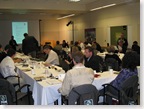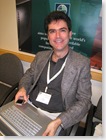Beyond Stories
 Yesterday I attended AMD's 50x15 partner summit in Sunnyvale, California. 50x15 is AMD's equivalent to Microsoft's Unlimited Potential, with the idea that 50% of the world's population can achieve access to the Internet and computers by the year 2015. In attendance were representatives from technology vendors (HP, Cisco, Dell, Nokia, Google, Sun, Microsoft), some NGOs, and even the guy who played Janice Soprano's narcoleptic boyfriend on season three of the show. (More on that later.)
Yesterday I attended AMD's 50x15 partner summit in Sunnyvale, California. 50x15 is AMD's equivalent to Microsoft's Unlimited Potential, with the idea that 50% of the world's population can achieve access to the Internet and computers by the year 2015. In attendance were representatives from technology vendors (HP, Cisco, Dell, Nokia, Google, Sun, Microsoft), some NGOs, and even the guy who played Janice Soprano's narcoleptic boyfriend on season three of the show. (More on that later.)
The meeting format was a day-long roundtable with about 50 people in the room. I have to confess after the first couple of speakers I was really worried that it was going to be a bad day. It's not because Tom McCoy or Dan Shine were poor speakers with little to say, it was just the opposite. They were interesting, with heartfelt and inspiring stories about ICT projects AMD had sponsored in emerging markets around the world. Great stories told with flair and LOTS of photos. AMD is doing really cool work.
really worried that it was going to be a bad day. It's not because Tom McCoy or Dan Shine were poor speakers with little to say, it was just the opposite. They were interesting, with heartfelt and inspiring stories about ICT projects AMD had sponsored in emerging markets around the world. Great stories told with flair and LOTS of photos. AMD is doing really cool work.
It's just that AMD's stories are pretty much the exact same stories that Microsoft tells, that Cisco tells, that Nokia tells, that Intel tells, that Qualcomm tells. I was worried that that I was going to sit through a day-long meeting listening to different vendors going through variations of the exact same storytelling approach we (I) use in UPG: sponsor pilot in remote location; go there and take pictures, tell the story, hope it spreads, and potentially accrue some goodwill for your company. Instead of being involved in a coordinated effort of "Doing well by doing good", by seeing for the first time what other vendors in this space are doing, it made me wonder ... are we all engaged in an exercise of "Feeling good by doing good?"
That's why I was worried it was going to be a bad day.
Don't get me wrong, these pilots have huge impact in the communities they serve, and you can see it in the faces of the people we film. Maybe I am too cynical, or maybe I was bummed with the realization that the work we were doing in UPG wasn't necessarily that original or unique.
But what I realized yesterday is that the emphasis on storytelling by vendors masks the two huge problems we need to address if we, as an industry, are going to move beyond stories and drive these programs to scale to achieve the true impact we all hope for:
- We need to figure out which projects actually work
- We need a better way for ICT vendors to work together
The first point is quite significant. The ICT4D community doesn't really have a systematic, objective, and agreed-upon way to measure the true outcome of these projects -- whether it's the design approach for a telecenter or a project for rural Internet access or a BOP student computing architecture -- that helps us determine if the project is scalable and sustainable. During the afternoon of the AMD summit there was a panel discussion that called for the creation of an online community to help share ideas around best practices or even ratings of different ICT4D projects, and this would be a good starting point. (We have kicked around the idea inside of Microsoft of starting one of these, send me a note if you are interested or would like to participate.) My gut feel is that ultimately market forces will pick what works, but the market may need some help in at least sharing ideas on what is out there in a consistent and accessible way.
On the second point, I wonder if we need some sort of industry manifesto or consortium to better integrate the efforts of different vendors involved in this space. A starting point might be some voluntary standards on how to document and report on the investment, shape, and outcome of these pilot projects we are all doing. This might be hard given that many of these projects are incubations for future products that will compete in the market (because emerging markets are in the end, well, markets) but if the technology industry can agree upon standards for measuring claims of system performance, we should at least be able to agree upon standards for measuring claims of social performance. The last thing we need is some heavyweight standards type effort that slows down our work or even worse sucks up resources that we could instead be spending in the field, but there are so many vendors engaged in these types of projects that there is clearly an opportunity for synergy. Perhaps this is an area where the Clinton crowd can help.
In the absence of wide-scale and repeatable successes driven by closer levels of cooperation among participants in this space, all we  have to rely upon for the time being are stories, and what ultimately made it a great day yesterday was that the quality of stories told at the summit were very, very good. The actor Turk Pipkin (the Sopranos guy) spent an hour going through the Nobelity Project, which centers around a documentary film he created involving interviews with 9 Nobel laureates discussing ideas on how to improve the world. (Attendees got copies of the film, and I may write
have to rely upon for the time being are stories, and what ultimately made it a great day yesterday was that the quality of stories told at the summit were very, very good. The actor Turk Pipkin (the Sopranos guy) spent an hour going through the Nobelity Project, which centers around a documentary film he created involving interviews with 9 Nobel laureates discussing ideas on how to improve the world. (Attendees got copies of the film, and I may write  a review in the next day or two.) Mathew Chetty (right) from AMD described some of the Learning Labs his company has in place in Africa, and it was great to hear the passion of an African describing ICT successes in
a review in the next day or two.) Mathew Chetty (right) from AMD described some of the Learning Labs his company has in place in Africa, and it was great to hear the passion of an African describing ICT successes in  Africa. Kristin Petersen, the founder of Inveneo, walked us through some of the projects her company is doing. Inveneo is interesting because they are essentially a non-profit systems integrator that does turnkey communication and computing solutions for NGOs, mostly in Africa. They
Africa. Kristin Petersen, the founder of Inveneo, walked us through some of the projects her company is doing. Inveneo is interesting because they are essentially a non-profit systems integrator that does turnkey communication and computing solutions for NGOs, mostly in Africa. They  also have created a skills certification program that will be the sort of thing we will need to sustain these projects from within local communities, especially in rural areas. Joe McCarthy from Nokia did a fly-by of some of the great projects his company is doing. This is clearly an area where I would like to learn more (I also plan to post pointers to the different slide decks people used.) Finally, Kate Stohr from Architecture for Humanity described how her group
also have created a skills certification program that will be the sort of thing we will need to sustain these projects from within local communities, especially in rural areas. Joe McCarthy from Nokia did a fly-by of some of the great projects his company is doing. This is clearly an area where I would like to learn more (I also plan to post pointers to the different slide decks people used.) Finally, Kate Stohr from Architecture for Humanity described how her group  took a simple idea -- volunteers doing architecture and design work in emerging markets -- and scaled it with minimal overhead to a mass phenomenon with hundreds of thousands of participants. She also had some sample chocolate bars from one of their projects in Ecuador that she handed out to the crowd.
took a simple idea -- volunteers doing architecture and design work in emerging markets -- and scaled it with minimal overhead to a mass phenomenon with hundreds of thousands of participants. She also had some sample chocolate bars from one of their projects in Ecuador that she handed out to the crowd.
So in the end I'd like to thank Dan Shine and the AMD 50x15 team for organizing a great summit yesterday, because it got me thinking about what we need to do beyond telling stories, creating a systematic way to get the projects to scale without sacrificing the sense of energy and hope that draws so many different types of people into this effort.